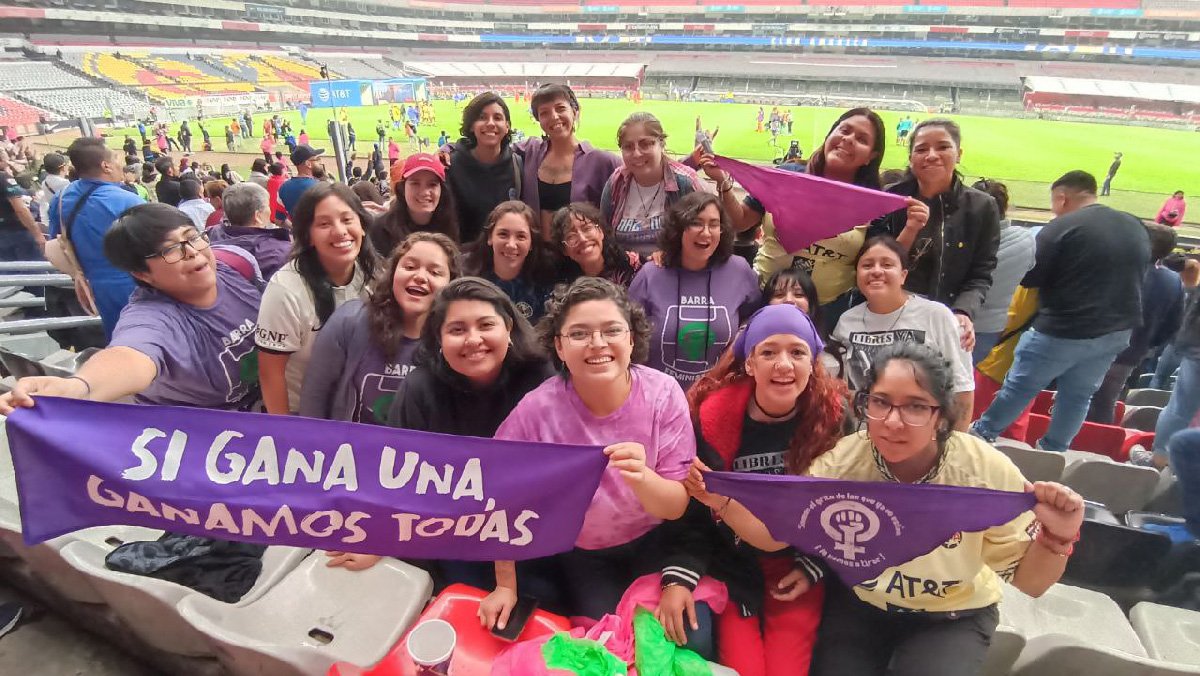Together, feminist fans are changing Mexican soccer
Illustration by Fernanda Justo for Ojalá.
Opinion • Fernanda Justo • June 1, 2023 • Leer en castellano
“Who are you cheering for?”
It's common for new folks to join us at Women's MX League soccer games; friends of friends or fans who have heard us before and want to take part in on our chants. Every game, without fail, someone comes up and asks us which team we support.
"All of them," we answer, all together.
The women who are part of the Barra Feminista [collective of feminist soccer fans] are diverse, as are the soccer teams we cheer for. Over our red and white, blue and gold, cream or striped team jerseys, we wear purple t-shirts and green scarves, integrating the colors of the feminist movement to give new meanings to old symbols and concepts.
Beyond supporting any particular team, we assert ourselves as the Barra Feminista. In Latin America, barras, or barras bravas, are similar, but not quite the same as hooligan firms in Europe. Traditionally, they are considered violent groups of fans with practices closely linked to aggression and humiliation, often of a sexual nature, turning the game into a war in which inevitably someone wins and someone else loses.
We take aim at these practices which, until now, have prevailed mainly in men's sport, and to show that there's another way of living soccer: through joy, listening and mutual support.
To do this requires we make space for the stories of individual and collective struggle that lie behind each of the women gathered in this stadium today: players, referees, coaches, trainers, health specialists, journalists, commentators, workers, fans, and more.
In Mexico there's supposed to be a ban on barras; in reality they continue to exist and carry out violent acts during men's soccer matches.
This has led security personnel to consider women wearing purple t-shirts and banners as a threat on various occasions, despite the fact that most of our messages are explicitly against violence in stadiums.
Around 10 to 15 members of the Barra attend each women’s league game, although there's a higher attendance in big matches or during finals. Most of us live in Mexico City, so we usually go to stadiums here or in nearby cities, such as Puebla, Pachuca, Querétaro and Toluca. Women in cities like Guadalajara, Monterrey and Tijuana are increasingly coming out to their local stadiums as part of the Barra. We use a Telegram chat to find each other and to see if anyone needs a ticket or has a spare one, or if there's a problem with our Barra Feminista t-shirts at the gates.
The first ones to arrive reserve as many seats as they can so we can all be together. Little by little, before the curious glances of the rest of the fans, our pack grows. We greet each other and catch up, keeping an eye out for those who have yet to arrive.
The Barra Feminista at the América-Juárez game at the Azteca Stadium in Mexico City, on May 22, 2023. Photo: Courtesy of Barra Feminista MX.
Some order beers from the vendor who already knows us because "we always come." He asks us if we think that the semifinals will be played in a better time slot, "so more people can come," he says. It's true, despite the appeal of this match, the turnout isn't that great. The executives keep putting women's soccer on the back burner, disregarding its growing popularity and the fact that, compared with earlier tournaments, the games are more intense with more goals scored, less time wasted, and fewer fouls.
Towards the women's championship
The women’s soccer quarterfinals, divided into two direct elimination matches, were held on May 22. This home game is played in the Azteca Stadium, Mexico’s largest, located in the country's capital. Las Bravas from Ciudad Juárez, the dark horse of the tournament, face the local Águilas del América, one of the strongest squads in the Women's MX League.
The 22 players on the field await with their hopes high, and the stadium falls silent for a brief moment, waiting for the starting whistle. The match kicks off, and so does our celebration of seeing the fall of the barriers that for so long separated us from the dream of pursuing the sport we love most.
Worldwide, women's soccer was banned for nearly half a century. In Mexico it’s 74 years behind: while men's professional soccer began in 1943, women's soccer only came into existence in mid-2017. Our Barra Feminista was born two years later, in 2019, trading collectible stamps from the Women's World Cup held in France.
"A chant, a chant!" someone calls. We whisper among ourselves to decide what to sing first. We settle on the most representative of the Barra Feminista. In one collective voice, alongside cheers for both teams, we roar, "Come and see them, come and see them! These are the women who play the football that I dreamed of!"
This chant's original lyrics are a well known, a patriarchal manifesto loaded with misogyny, especially against sex workers. We transformed them to honor those who take to the field today and in doing so became heroines for all those who wanted to play but couldn't, for those who played against all odds, and especially for the youngest girls who want to grow up to be like them.
That's why we're so moved to hear the young girls join us in song and carry these words with them as a shield, should anyone ever try to convince them that football isn't for them.
The visiting team scores the first goal. Moments later it's annulled due to an illegal position.
We see relatives of the away players nearby, so we cheer with them for Bravas. Time goes on and the locals manage to score two goals.
Just like in every game we attend together, the people around us don't quite understand how we switch from celebrating one team's goals to cheering for the other team's players. We sum it up with another chant: “If one wins, we all win!”
We're convinced that the individual drive and dedication of each player is part of a collective success. They’re now competing in one of the most emblematic stadiums in the history of football, and we are in the stands cheering and chanting for equality in sports. This too is thanks to the struggle of others, who have passed the ball on to us.
The struggle against all forms of violence
Midway through the second half the score was 3-1 in favor of the Águilas. As the game came to an end, the differences between the teams began to show, likely a reflection of inequalities off the field.
The Women’s MX League has 18 teams organized into a single division. A separate U-17 league was created in May 2021. Despite the league's short journey on the path towards professionalization, it has quickly become one of the top 10 worldwide. However, there's still a huge disparity in how clubs allocate resources to their women's squads, some funding them more adequately while others only comply with the bare minimum, statutory obligation to have a team in the category.
An outrageous wage gap still exists between male and female soccer players. In 2021, the average monthly salary for men in the MX League was US$37,697, while that of female soccer players was a mere US$422 a month. Another glaring discrepancy is the lack of effective protocols to ensure female players can practice and play in a safe environment, free of violence.
The case of Scarlett Camberos is top of mind. Camberos is a former Águilas player, now with Angel City FC, who had to leave the country in the middle of the current tournament due to serious and constant sexual harassment. Neither her club, nor the league, nor the Mexican justice system were able (or willing) to protect her.
As women who love soccer, we call out and organize to fight these and other forms of violence.
That's why we center the practice of collective care and seek to create a safe space by women for women based on our passion: living the sport and occupying the territory-stadium with our bodies and our voices.
Our presence in the stands is born from desire and joy, but also from the political struggle for public space from which the most regressive elements in society still try to banish us. We refuse to surrender even a single centimeter of the space we’ve won on the fields.
The match is over, but the highlight of the tournament is yet to come.
The score is the least of it. The players—once again—gifted us a game filled with emotions; for that we can only thank them. But for all of, there’s still a long way to go.
For the Bravas, the goal is to consolidate the project that earned them a place in the top eight this season, proving to other clubs that financial investment (salaries, recruitment of players and staff, infrastructure) pays off.
For the Águilas, who a week later came out victorious in the semifinal against the Amazonas of Tigres, it's a push to win their second Women's MX League title in their upcoming games against the Tuzas of Pachuca.
And for the Barra Feminista, it's back to making sure we all make it home safely, discussing the tournament, coordinating attendance at the next matches and, above all, to the enormous challenge of continuing to bet on making another kind of soccer possible, strong in our belief that a team sport such as this is best enjoyed collectively.
The Barra Feminista, moments before the final game of a street tournament held in the Zócalo of Mexico City on March 9, 2023. Photo: Courtesy of Barra Feminista MX.




